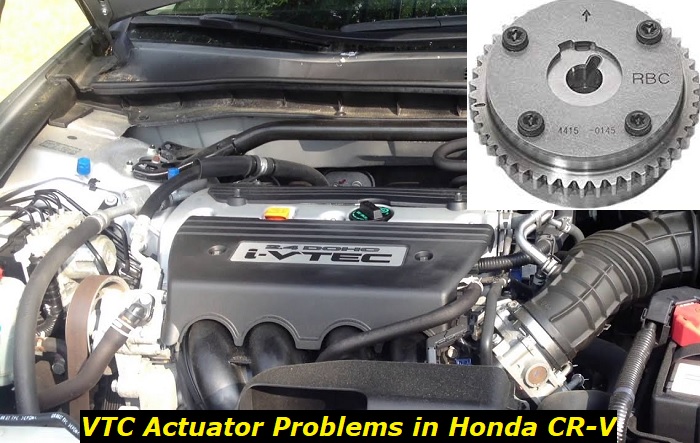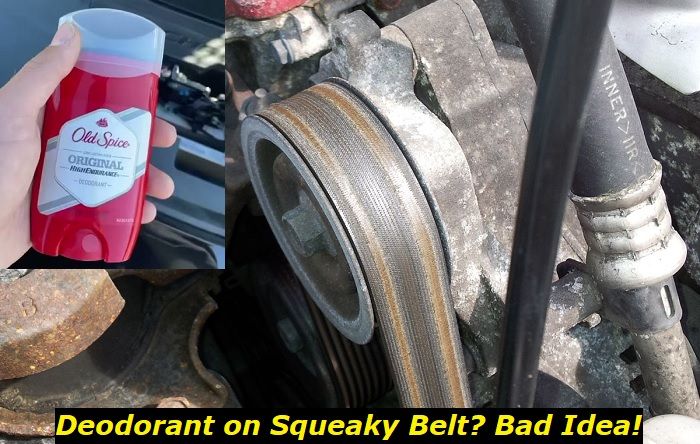Do you have a Honda CR-V that rattles when you start the car? A bad VTC actuator can cause some serious rattling or grinding noises from the engine during a cold start. Any sort of noise from the engine is a significant worry, in terms of repair cost, and possible future damage. But what causes a bad VTC actuator, and how much will you need to spend to get it replaced?
Camshaft problems highlights
- Level of importance:Medium
- Commonreasons:Variable valve timing actuator problems, cam bearings issues, overheating
- DIY inspection:Possible but complicated
- DIY repair:Impossible
- Price for repair:$350 - $850
- Can you drive?Usually, yes
- Ways to fix:Clean the VVT (VCT) solenoids, inspect the camshaft, clean the valves

What is a VTC Actuator?
In a Honda vehicle, the VTC actuator refers to the Variable Valve Timing Controller actuator. This is a part of the engine's valvetrain that can adjust the timing of the intake and exhaust valves. It does this by adjusting the position of the camshaft relative to the crankshaft.
Using data from the car's computer and sensors, the VTC actuator can make the car perform more efficiently by adjusting the timing of the valves to match the vehicle's current needs. By adjusting the valves to produce less power than necessary, the VTC actuator can also optimize fuel efficiency.
What are the Symptoms of a Bad VTC Actuator?
While VTC actuators are invaluable in how they optimize the fuel efficiency and performance of Honda vehicles, they have a reputation for failing frequently. Many Honda vehicles, like the 2008-2012 Honda Accords, have had recalls issued on bad VTC actuators.
If you suspect that you might be saddled with a bad or failing actuator, you can confirm your suspicions by looking out for one or more of the telltale symptoms.
- Grinding, rattling, or knocking noise from the engine.
- Rough vibration during start-up.
- Hard starting in cold temperatures.
- Engine power is lower than usual at high speeds.
- Decreased fuel economy.
- Rough idling.
- Check Engine Light is illuminated.
What are the Reasons for a Bad VTC Actuator?
Like the VTC actuators in most other Honda vehicles, the actuator in the Honda CR-V is prone to going bad and failing. There are some preventative measures you can take to make sure your actuator lasts as long as possible. Knowing how a VTC actuator can fail will help stretch the life of your actuator as much as possible.
1) Lack of Clean Oil
The VTC actuator is actuated through hydraulic pressure. This hydraulic pressure is generated by the oil pressure in the engine, so it's clear how important it is for the actuator to receive a good supply of clean oil.
If the oil level is too low, the VTC actuator won't have sufficient hydraulic pressure to move and adjust the camshaft. This is easily solved by topping up the oil in the engine.
Dirty oil is a more serious problem for the VTC actuator. The actuator uses oil pressure to move the camshaft. If the oil is dirty, this can cause sludge and debris to form a blockage inside the actuator. A blocked actuator won't be able to generate hydraulic pressure and will fail. Dealing with a blocked actuator will require a replacement.
It's worth noting that a lack of clean oil won't just prevent the actuator from moving but could also result in premature wear on its moving parts.
2) Short Drives
One of the symptoms of a bad VTC actuator is rattling during a cold start. This happens when there is no hydraulic pressure inside the actuator because the engine oil is still cold. As the engine runs, the engine oil warms up and the car starts to generate oil pressure. This oil pressure will push oil into the actuator, allowing it to function properly.
If the car is only taken on short trips, the engine won't have enough time to warm up, meaning the actuator won't receive enough oil. This will affect its operation and cause premature wear on the actuator that can eventually make it break down.
The best way to prevent this is to take your car on long drives. If you need to take your car on short drives, you should allow the engine to warm up first so that the engine can build up suitable oil pressure.
3) Wear and Tear
One of the most common causes of a faulty VTC actuator is wear and tear. A VTC actuator uses hydraulic pressure to operate and has a lot of moving parts. These parts can wear down over time, especially in the absence of suitable engine oil.
When the actuator wears down, it will not be able to adjust the position of the camshaft suitably, which can result in reduced power and fuel efficiency.
The VTC in a CR-V will usually break down after about 50000 miles, even with regular maintenance. Taking care to let the engine warm up, and supplying the engine with clean oil let you get the most out of your VTC actuator. However, you will still need to deal with a bad VTC actuator eventually.
Can a Bad VTC Actuator Be Ignored?
The effects of a bad VTC actuator tend to be somewhat varied. Some CR-V owners note that their car rattles violently on start-up and drives smoothly afterward. Some notice a grinding sound as they drive, along with increased emissions and reduced fuel efficiency. Others only notice rattling after a cold start. Because some drivers don't notice serious symptoms, a common concern is whether you can afford to ignore a bad VTC actuator.
If your VTC actuator has gone bad, your engine will continue to operate normally for a while. The valves will continue to open with the correct timing, though the variable timing feature will not be effective. There will be a reduction in power and fuel efficiency under certain conditions as a result, but the engine will continue to run.
The real problem is what comes later. Every time the VTC actuator grinds, it stretches the timing chain. Over time, the timing chain will stretch to a point where the engine's valve timing degrades. This is a much more serious problem that will require additional repairs.
To avoid costly timing chain repairs, you should have your VTC actuator problem dealt with as soon as possible.
How to Repair a Bad VTC Actuator?
If your engine is rattling and you find out that you've got a bad VTC actuator, the next thing on your mind will be how to fix it. Can a bad VTC actuator be repaired, or does it need to be replaced?
Unfortunately, once a VTC actuator starts to go bad, it's pretty much gone. A bad VTC actuator can't be repaired. The best course of action is to have the faulty actuator replaced so that your car can go back to normal.
Replacing a bad actuator is not an easy task. It requires removing the valve cover and the camshaft. If you have sufficient mechanical experience, you can replace it yourself and save on labor costs. However, if you don't have sufficient experience, it's better to have a mechanic make the repairs for you. There is a lot that could go wrong when replacing the actuator. It's not worth risking something going wrong and incurring more expensive repairs.
Speaking of costs, how much will you be looking at when it comes to replacing your engine's VTC actuator?
How Much Does It Cost to Replace a VTC Actuator?
Replacing a VTC actuator is a somewhat costly procedure. Most of the price of the replacement comes from labor costs if you choose to have a mechanic make the replacement for you.
The price of a VTC actuator will vary depending on where you purchase it. However, a Honda CR-V VTC actuator is not prohibitively expensive and will usually set you back between $150-190.
If you choose to have a mechanic make the replacement for you, then you should expect to pay around $450 and $580 for labor costs.
This comes to a total of $600-770 to purchase the replacement and have it installed.
Conclusion
The Variable Valve Timing Control actuator is a part of the valvetrain in Honda vehicles that controls the timing of the valves in the engine. It adjusts the opening of the intake and exhaust valves to optimize the performance and fuel efficiency of the engine.
In the Honda CR-V and many other Honda vehicles, the VTC actuator is prone to breaking down quickly. In the Honda CR-V, the VTC actuator breaks down within 50000 miles as a result of wear, or oil starvation. A bad actuator will need to be replaced. This process will usually cost somewhere between $600 and $770 depending on where you choose to repair it.
About the authors
The CarAraC research team is composed of seasoned auto mechanics and automotive industry professionals, including individuals with advanced degrees and certifications in their field. Our team members boast prestigious credentials, reflecting their extensive knowledge and skills. These qualifications include: IMI: Institute of the Motor Industry, ASE-Certified Master Automobile Technicians; Coventry University, Graduate of MA in Automotive Journalism; Politecnico di Torino, Italy, MS Automotive Engineering; Ss. Cyril and Methodius University in Skopje, Mechanical University in Skopje; TOC Automotive College; DHA Suffa University, Department of Mechanical Engineering






Add comment